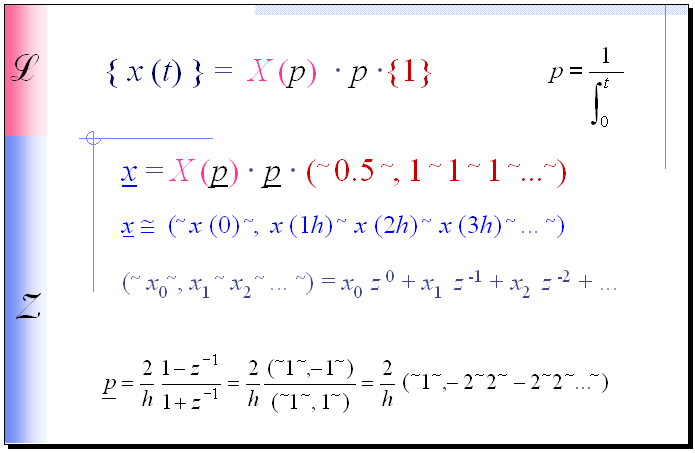Andrzej Kubaszek
Rzeszów University of Technology,
Rzeszów, Poland
Discrete representations of generalized time domain function in symbolic-numerical analysis
This presentation is available at
https://pei.prz.edu.pl/~kubaszek/smacd06/
INTRODUCTION
Computer simulation sometimes leads to the results, which can be supposed as the numerical instability. It is shown, that some of that results should be accepted – they are generalized time domain functions in Mikusinski operational calculus, and after some operations they can be useful solutions.
There are problems with javascript (or with "innerHTML")...
This way we get discrete equivalence of abstract functions, like derivative of non-smooth function or function containing negative delay.
Instructions fo use the graphs:
-
Move mouse over left plane; click.
-
To refresh initial text click central plane.
-
Edit numbers in borders to change range of the axis.
-
Gray number have an influence on rounding process, for example:
shown value = round(x*100)/100
-100 have an influence on shown value and on parameter value (granularity)
-
(Wait a moment for ruffle - the Flash Player emulator - to load. Some characters are not visible in the chart headers. The correct formulas are on the right. Similar interactive charts that do not require Flash Player are available on
observablehq.com )
CONCLUSIONS
-
Repetitive symbolic-numerical time domain analysis which take into account generalized functions illustrates abstract functions introduced 50 years ago by Mikusiński, like derivative of non-smooth function or function containing negative delay operator [>>]
-
Although series of samples of these functions pretend numerical instability case, although sampling theorem seems to be broken, discrete equivalences of such functions act the same way as in continuous time domain.
-
Repetitive analysis and interactive graphs demonstrate unusual properties of discrete
approximations of these functions.
-
Knowledge regarding special properties of sequences of samples of such functions can be utilized to test or to improve DSP algorithms.

Discrete representations of generalized time domain function in symbolic-numerical analysis.
Andrzej Kubaszek,
Rzeszów University of Technology,
Rzeszów, Poland.
https://pei.prz.edu.pl/~kubaszek/smacd06/
